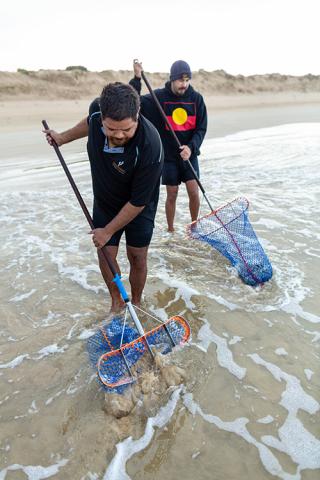Price premiums are one potential benefit of Indigenous brands, but new FRDC-funded research shows strengthening communities and creating employment are stronger drivers.
With the growing involvement of Indigenous fishers and their communities in Australia’s commercial seafood sector, there has also been growing interest in the economic benefits of creating Indigenous seafood brands.
To better understand branding opportunities, FRDC commissioned market research to assess existing Indigenous food brands in Australia and overseas (2020-121).
Ewan says the project was initiated by FRDC’s Indigenous Reference Group, and he considered Indigenous ownership and employment as important aspects of the brands he assessed. From the initial selection, he examined 24 brands in more detail: 13 in Australia, seven in New Zealand, two in the US, and two in Canada. These included:
|
Australian food companies:
Australian seafood companies:
New Zealand food companies:
Canadian food companies:
US food companies:
|
Researcher Ewan Colquhoun, from Ridge Partners, initially identified 55 businesses with 69 brands in Australia, New Zealand, the United States (US) and Canada, for assessment. Given the limited number of Indigenous seafood brands, he looked more broadly at food brands.
Improved sales
Of the 24 enterprises assessed in detail, 13 acknowledged economic benefits from Indigenous branding, primarily through increased sales. Longer established enterprises also reported higher prices and increased profit margins.
These included seafood companies Moana New Zealand and Goolwa PipiCo, but both indicated it was difficult to quantify how much Indigenous branding contributed to price premiums.
This is because their brands represent one of a larger group of attributes that customers are seeking, such as sustainable fisheries management, Marine Stewardship Council certification, brand reputation and product convenience.
Ewan says that while brands are generally created to boost sales and economic value, for many of the enterprises economic gain from Indigenous branding was not necessarily the primary motivation.
“The branding was an internal function, a way of bringing Indigenous people together into an entity. It may be tied to the customary production of food or fishing on country and positions them as a community that is proud of its heritage,” he explains. Commercial leverage of the brand may come later.
Alignment with culture
“An alignment with Indigenous culture and a commitment to country are often essential elements of these brands. Internal stakeholders commit to this over time before putting the brand to external commercial markets.”
He points to the Blackfella Beef label, from Western Kangoulu Ltd. This business has brought together Indigenous communities in central Queensland to manage the grazing and cattle production on customary land. Ewan says that through Western Kangoulu, Indigenous people across the region have come together with both a cultural and commercial purpose. Their leaders have developed plans that are generating jobs and attracting sponsorship opportunities.
He also points to a previous FRDC-funded project he undertook (2016-244) which looked at the potential of a brand for Torres Strait Island seafood including prawns and Tropical Rock Lobster (Panulirus ornatus), and the competitive advantages of those branded products. This became the basis of the recently launched Zenadth Kes Fisheries, jointly owned by communities.
But the enterprise itself will not be enough to develop the brand, says Ewan: “There are 18 islands in the Torres Straits and two mainland centres and each one has a unique community. To build a brand that really encompasses these islands will need many elements to align. Supporting the enterprise that markets their product, they need a shared vision; the community needs to come together to build that.”
For some of the enterprises he interviewed, this commitment was more important to the foundation of the business than incorporating an Indigenous identity into the brand for marketing purposes.
Most of the Australian businesses evaluated in the research are relatively new to the market when compared to international companies, some of which have been operating for 20 years or more.
The oldest Australian brand Ewan assessed is the Coles Ltd Outback Spirit range of bush foods, established by the national supermarket chain in 2001. It is funded through its Indigenous Food Fund. A proportion of proceeds is used to develop Indigenous supply chains and promote bush foods.
The most sophisticated Australian Indigenous seafood branding comes from Goolwa PipiCo, which was established in 2014. In 2019 this private company formed a joint venture with the KutiCo, a wholly Ngarrindjeri owned company. The Goolwa PipiCo and KutiCo have established complementary but differentiated brands, while training Aboriginal people to work in the pipi fishery.

Training and employment are key objectives for the joint venture between Goolwa PipiCo and KutiCo.
Native title impact
Looking at the regulatory framework, Ewan says native title settlements are providing impetus for new Indigenous ventures across Australia.
However, more advanced legislation in countries such as New Zealand, the US and Canada, coupled with government support, have helped to establish Indigenous enterprises which re-invest profits into social and business services to support Indigenous communities.
FRDC Senior Research Portfolio Manager Josh Fielding says discussions around Indigenous brands have often focused on Western perspectives of money and profits, however this research has pointed to a more holistic perspective and broader community benefits.
Josh says the Indigenous branding project will help inform the perspectives and guidance provided by the Indigenous Reference Group. “It will also inform our future research and relationships to support Indigenous fisheries and self-determination for Indigenous communities.”
“At a national level, FRDC has had a Memorandum of Understanding with the Indigenous Land and Sea Corporation for several years. We’re also looking at how we can develop relationships and support state-based Indigenous groups.”
Related projects
- 2020-121: Indigenous Branding in the Fishing and Seafood Industry - Economic Creation and Capture
- 2016-244: TSRA: Assessing direct export feasibility, marketing, and branding opportunities for Torres Strait Fisheries derived products:
This relates to R&D Plan Outcomes 1, 2 & 5





